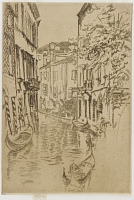Etchings Institutions search term: grolier club
Quiet Canal | ||
| Number: | 224 | |
| Date: | 1879/1880 | |
| Medium: | etching and drypoint | |
| Size: | 229 x 154 mm | |
| Signed: | no | |
| Inscribed: | no | |
| Set/Publication: | 'Second Venice Set', 1886 | |
| No. of States: | 4 | |
| Known impressions: | 35 | |
| Catalogues: | K.214; M.211; W.184 | |
| Impressions taken from this plate (35) | ||
KEYWORD
TITLE
'Quiet Canal' (1883, F.A.S.). 1
'The Quiet Canal' (1886?, Whistler). 2
'Quiet Canal' (1886, Frederick Wedmore (1844-1921)). 3
'Quiet Canal' (1890/1891, Whistler). 4
Clearly 'Quiet Canal' is the generally accepted title.
1: London FAS 1883 (cat. no. 47).
2: List of 'Venice 2nd Series', GUW #13088.
3: Wedmore 1886 A (cat. no. 184).
4: List, [1890/1891], GUW #13236.
DESCRIPTION
SITE
5: Grieve 2000 , pp. 85, 200; E.T. Cook & A. Wedderburn, The Works of John Ruskin, London, XI, p. 431; I. Bliss, R. Garside, R. Haslam (eds.) Ruskin's Venetian Notebooks 1849-1850, 2008, 'House No 72, Gothic Book, p. 33', Ruskin Library website at http://www.lancs.ac.uk (accessed 2012).
6: H. James, Italian Hours, London 1909, f.p. 24.

